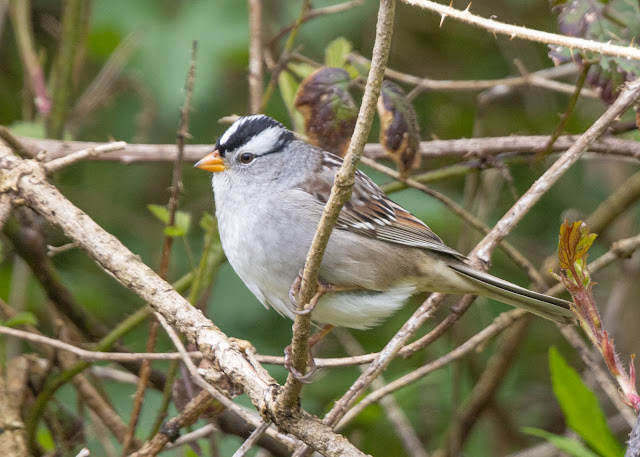No, this blog is not about my beloved Seagulls, so cruelly robbed of their rightful place in the FA cup final last weekend by the devils spawn of Manchester! Rather, it is about an exceedingly rare American vagrant which has been found in Sussex, namely a Gambel’s White-crowned Sparrow.
The White Crowned Sparrow is a common passerine of North America, indeed I have seen and photographed many on my numerous work and pleasure visits there. In contrast, with only 11 prior UK records, it is a very rare accidental visitor to the UK. Even those 11 records belie the fact that most have been short and hard to twitch visitors to the remote Scottish isles. So when one was found last Saturday at a place called Seaford Head in Sussex it immediately caught my attention. As the weekend wore on, however, it became apparent that the bird was extremely elusive with some observers spending 12 hours on site without seeing it. Given this and my recent big dip of a Forster’s Tern, my enthusiasm for an immediate visit was dampened.
Fast forward to Wednesday this week when it became clear that the bird had become much more doable curtesy of a seeded area put down by other birders. So off I set bright and early on Thursday on the 3 ½ hour drive to its location at the coastal Seaford Head nature reserve. I parked in the small busy car park and followed other birders instructions to the location, a small hillside path surrounded by bushes, brambles, and other vegetation. A group of fellow birders were standing on the path a way back from the seeded area and I was told that it was coming to the front of the bushes quite regularly. After a nervous wait of 10 minutes, and some difficulty getting onto the bird back in the dense undergrowth, I had my latest UK tick.
It is a medium-sized member of the New World sparrow family, with a grey face and black and white streaking on the upper head, a description which hardly does this beautiful little bird justice! The Sussex bird had been identified as belonging to the subspecies gambelli, perhaps not too surprisingly as this is the subspecies that is most migratory breeding as far north as the Artic Circle before migrating to the southern United States and north Mexico for the winter. This subspecies is subtly different from the nominate species, nuttalli, being distinguished by having pale lores and a yellow, as opposed to the nuttalli’s pinkish, bill.
It spent a lot of the time somewhat obscured in the undergrowth but would occasionally come to the front and then drop down onto the ground at the back of the seeded area where it would remain partially hidden in the ground cover. On one joyous occasion it came right to the front and out into the open and spent a few minutes feeding on the seeds.
The White-crowned Sparrow is closely related to the American White-throated Sparrow which, coincidently, I also saw in Sussex a few years back.
 |
| White-throated Sparrow |
Also for reference here is the nominate subspecies nuttalli taken in Canada a few years back.
As is so often the case when I’m out indulging in my passion for birding, time passed quickly in the pleasant company of like-minded souls and my beautiful feathered friend and it was soon time to leave for the long journey home utterly at peace with the world after my latest major dose of avian therapy.













Very good and an interesting read. Thanks.
ReplyDeleteBeautiful photos.
ReplyDelete